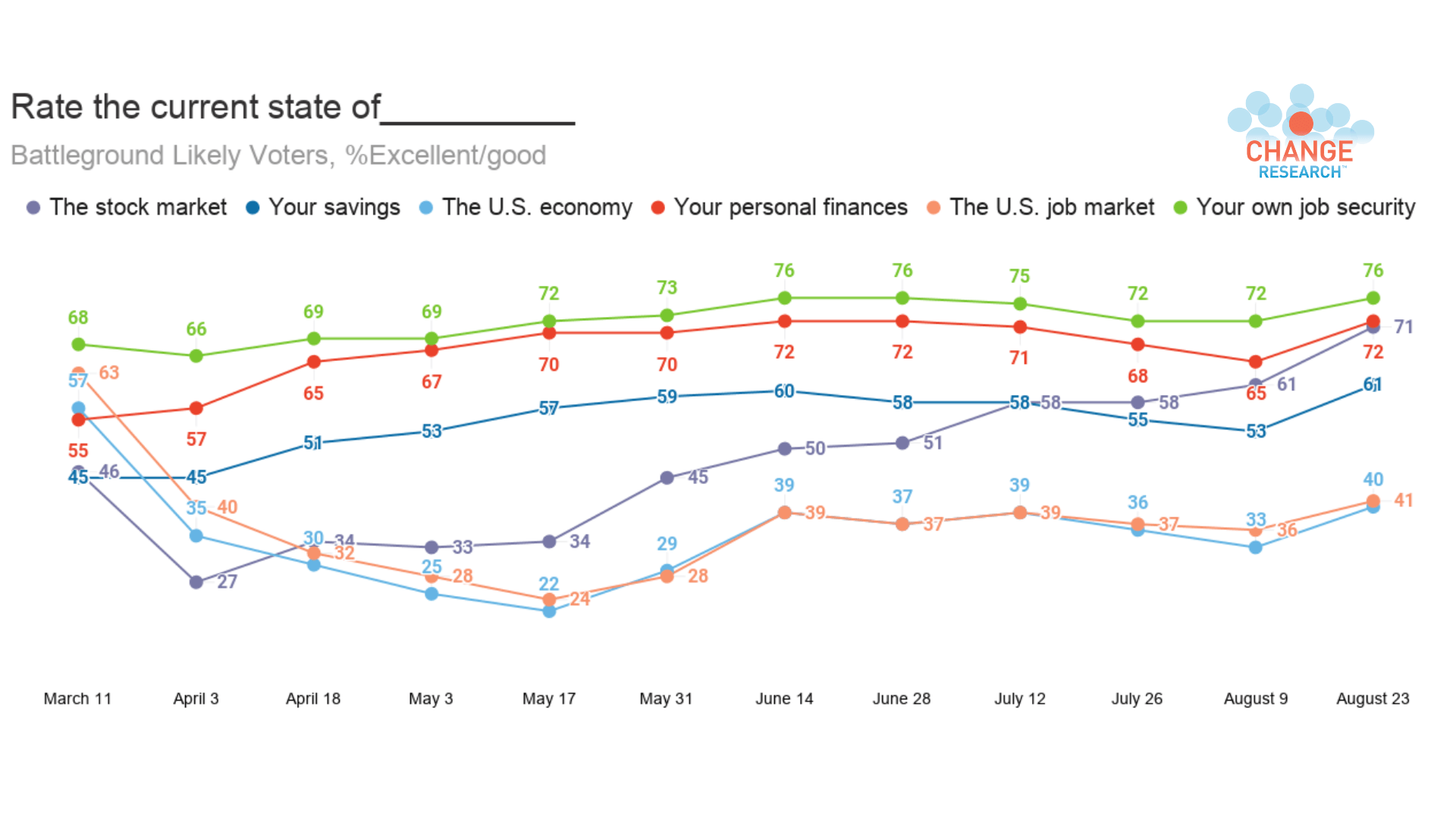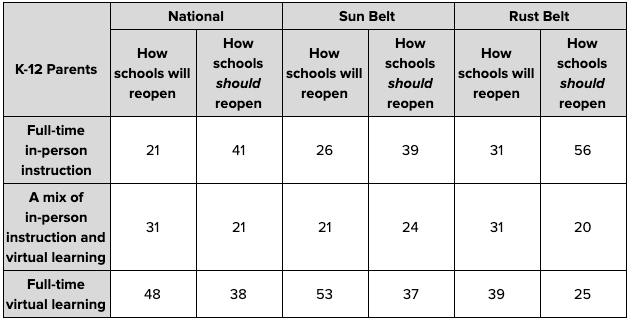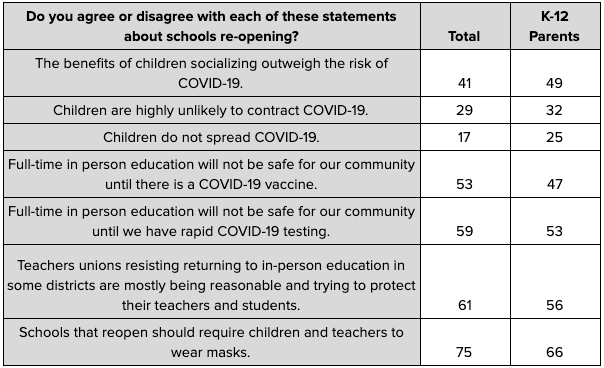Change Research/ CNBC Poll: August 21-23, 2020
Key Takeaways
- Biden leads 51% to 43% nationally and 49% to 46% in the battleground, including a lead in all 6 states (Arizona, Florida, Michigan, North Carolina, Pennsylvania, Wisconsin.
- In the battleground, serious concerns about COVID-19 ticked down 4 points, approval of Trump’s handling of COVID-19 rose 3 points to 47% (the highest it has been since May 17 when it was 49%), and his overall job performance rating rose 2 points to 48%.
- Despite increases in opinions of the state of the economy, majorities nationally disapprove of the job Trump is doing handling the economy (53% disapprove) and helping people’s pocketbooks (54% disapprove).
- 33% of voters nationally and in the battleground intend to vote by mail, down 5 points in the battleground and 3 points nationally. Still, opinions of the USPS are +57 net favorable nationally and +53 net favorable in the battleground.
- Parents are more likely to believe that it is safe for children to attend classes and daycare than all voters, and 47% of parents in the battleground, and 41% of parents nationally say that at this stage that their child’s school should reopen for full time in person instruction.
The DNC, VP Pick, and the Ballot
A 64% majority of voters nationally and 57% of battleground voters report having watched the DNC last week, with 23% nationally and 22% in the battleground saying they watched the entire convention. Of course, Democrats were the most likely to watch the DNC (83% nationally, 82% in the battleground), but a majority of independents (60% nationally, 54% in the battleground), and even a large minority of Republicans (43% nationally, 34% in the battleground) report watching it.
A similar number intend to watch the RNC this week (62% nationally, 59% in the battleground), with roughly a quarter intending to watch all of it (24% nationally, 26% in the battleground). Unlike the DNC, the RNC is expected to include some in-person gatherings, even though only 28% nationally and 33% in the battleground believe it is safe to attend indoor campaign rallies at this stage in the COVID-19 outbreak.
Of those who watched the DNC, 71% of battleground voters and 70% nationally had a positive reaction to Joe Biden’s speech and 60% of battleground voters and 56% nationally had a very positive reaction. The criticism of the DNC by some in the Democratic Party does not reflect the prevailing opinion of Democratic voters. Democrats were universally favorable in their reaction to Biden’s speech (98% in the battleground), as were 63% of independents and even 11% of the Republicans who watched it.


There is a small post-convention bump for Biden nationally (+6 to +8), though still within the margin of error, and there was not a statistically significant shift in the 6 state battleground where Biden leads by 3 points overall. There were greater improvements in opinions of Biden over the past two weeks, however. There was a 3 point positive shift in net-favorability in the battleground (+4 net unfavorable: 45% favorable, 49% unfavorable) and the number very favorable has increased 6 points (27% very favorable to 33%). Nationally, there was a 4 point shift in net favorability from +6 to +2 net unfavorable (46% favorable, 48% unfavorable).
Kamala Harris was also selected as Biden’s running mate, spoke at the DNC, and has appeared alongside Biden several times since we last fielded. Opinions of Kamala closely mirror opinions of Biden nationally (+2 net unfavorable) and in the battleground (+4 net unfavorable). Likewise, Mike Pence is 6 points net unfavorable in the battleground and +15 net unfavorable nationally. Opinions of Mike Pence are slightly less favorable, and also mirror opinions of his running mate – +13 net unfavorable nationally and +6 net unfavorable in the battleground.
Trump Job Performance
Nationally, 71% have serious concerns about COVID-19, unchanged from two weeks ago, 42% approve of the job Trump is doing handling COVID-19, unchanged from two weeks ago, and his overall job performance was stable at 45%. In the battleground, serious concerns about COVID-19 ticked down 4 points, approval of Trump’s handling of COVID-19 rose 3 points to 47% (the highest it has been since May 17 when it was 49%), and his overall job performance rating rose 2 points to 48%.
Opinions about how Trump is handling COVID-19 are identical to opinions about how he is doing when it comes to ensuring schools reopen safely – 43% approve nationally and 48% approve in the battleground. Trump gets his lowest marks on ensuring schools reopen safely in the states with Democratic Governors (44% approve in MI, 48% approve in NC, 47% approve in PA, 46% approve in WI) while voters are split 50/50 in Arizona and Florida. A 56% majority nationally and 52% in the battleground say Biden and Democrats would do a better job handling COVID-19. Biden and Democrats also have an identical advantage on the issue of ensuring schools reopen safely (+12 nationally, +4 in the battleground).
Trump and the economy
The economy, jobs and cost of living remain the number 1 issue in the country and in the battleground. This issue was supposed to be Trump’s strength and his best case for re-election before COVID-19, but majorities nationally disapprove of the job he is doing handling the economy (53% disapprove) and helping people’s pocketbooks (54% disapprove), and only 51% approve of his handling of his handling of the economy and pocketbooks in the battleground. Likewise, voters nationally prefer Biden and Democrats when it comes to recovering from the economic impact of COVD-19 by 6 points (53% Biden to 47% Trump) while battleground voters are split 51% Trump to 49% Bden.
What is most interesting about Trump’s failure to secure a significant advantage on his key issue is the fact that we saw a 6 point improvement in views of the economy and views of the US job market in the battleground over the past two weeks, as well as a 6% decrease in pessimism about the US economy and the unemployment rate. These shifts appear to come primarily from Arizona, Florida, and Wisconsin, and while the shifts among Republicans were the most significant, the assessment and outlook of Democrats and independents also improved. To be sure, 60% of battleground voters still rate the economy negatively, 59% still rate the US job market negatively, 51% are still pessimistic about the US economy in the year ahead, and 56% are still pessimistic about the unemployment rate. But this is also the first time that we have seen these economic metrics moving in a positive direction in several weeks.

Voting by mail
When we last surveyed, 38% of battleground voters and 36% nationally expressed their intention to vote by mail in the upcoming election. Since then, very serious news about changes to the USPS, including the removal of mail sorting machines and mailboxes, has come to light. Voters have become less inclined to vote by mail as a result. Presently, 33% of voters nationally and in the battleground intend to vote by mail. Democrats, the group most likely to say that they intend to vote by mail, shifted the most over the past two weeks: 51% of Democrats nationally intend to vote by mail, down 11 points, and 57% of Democrats in the battleground intend to vote by mail, down 7 points.
Despite the negative news about the changes to mail service, the USPS is still a very popular American institution. Opinions are +57 net favorable nationally and +53 net favorable in the battleground, with Democrats, independents, and Republicans all net favorable.
School closures
Only 40% in the battleground and 36% nationally say it is safe for students to return to school and just 38% in the battleground and 33% nationally say it is safe for children to go to daycare. Parents are more likely to believe that it is safe for children to attend classes and daycare than all voters, but that they are still fairly divided. (Interestingly there is a big divide between the parents of students in college and current college students — 74% of current college students nationally say letting students return to school is not safe.


Of those with children in K-12 school, nearly half will be returning to school this year with virtual learning full time (46% in the battleground 48% nationally). It is the sunbelt states where there will be the most virtual learning (53% versus 39% in the rust belt). Just 21% nationally and 28% in the battleground will resume with full time in person education. But the preference is for full time in person instruction – 47% in the battleground, and 41% nationally say that at this stage that their child’s school should reopen for full time in person instruction. In the rust belt, 56% say they want schools to reopen fully, while just 39% say that in the sunbelt.

Of those who are starting school part time or full virtual, there are a number of strategies they are using to adapt.
- 48% are buying additional technological devices
- 36% are asking friends or family to help supervise
- 32% are quitting a job or working fewer hours to supervise
- 14% are looking to enroll my child in a school that is conducting in-person classes instead
- 12% are assembling a learning “pod” with a few other families
- 9% are hiring a private tutor
- 9% are hiring additional childcare to supervise.
There is a significant difference in the reactions of parents of K-12 students and all voters when it comes to the risks and rewards of returning to school. This is a critical conflict brewing because parents are more likely to see rewards to reopening and discount risks, even though all voters would be at risk if community spread occurs as a result of school reopenings.

One thing everyone agrees with in equal measure is that colleges and universities should not charge full price for virtual classes: 84% of all voters nationally, 86% of parents of college students and 86% of college students agree with that.
Finally, people are increasingly thinking about teachers and the teachers unions in this debate about reopening. Voters are net favorable towards both teachers (+60 in the battleground, +63 nationally) and teachers unions (+12 in the battleground, +17 nationally) as we begin the discussion about reopening schools.
For media inquiries, please email [email protected]
Change Research conducted a poll of 4,904 likely voters August 21-23, 2020 across 6 competitive battleground states: Arizona, Florida, Michigan, North Carolina, Pennsylvania, and Wisconsin. A companion national survey of 2,362 likely voters was also conducted August 21-23, 2020. Unless otherwise stated, the results presented in this analysis are among battleground state voters. The margin of error, as traditionally calculated, is ±1.4% for the battleground and ±2.02% for the national poll. Change Research reaches voters via targeted online ads that point people to an online survey instrument. Our Dynamic Online Sampling establishes and continuously rebalances advertising targets across region, age, gender, race, and partisanship to dynamically deliver large samples that accurately reflect the demographics of a population. Post stratification was done on state, gender, age, race, education, and 2016 presidential vote.
This is the twelfth in a series of bi-monthly battleground state and national surveys that CNBC & Change Research will conduct in 2020.
